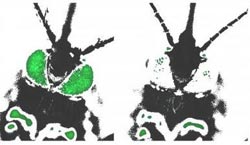Mosquitoes reared in cooler temperatures more susceptible to viruses that can affect human health

This image shows green fluorescent protein in the eyes of the mosquito Aedes aegypti when immunocompromised by cooler temperatures (left) compared with an immunocompetent sibling (right).<br><br>Credit: Virginia Tech<br>
Urban epidemics resulting from viral diseases, such as West Nile fever and chikungunya fever, are transmitted by infected mosquitoes.
According to Virginia Tech scientists, mosquitoes reared in cooler temperatures have weaker immune systems, making them more susceptible to dangerous viruses and more likely to transmit them to people.
The connection between temperature and the mosquito's immune system, published Friday (May 31, 2013) in PLOS Neglected Tropical Diseases, is significant in light of global climate change, said researchers Kevin Myles and Zach Adelman, associate professors of entomology in the College of Agriculture and Life Sciences, and affiliates of the Fralin Life Science Institute.
“Our data offers a plausible hypothesis for how changes in weather influence the transmission of these diseases and will likely continue to do so in the future,” Myles said.
A variety of weather anomalies may occur with global changes in climate. However, predicting what these weather anomalies will be is difficult due to the enormous complexity involved. Nevertheless, the work of Myles and Adelman suggest that it would be unwise to focus solely on warmer temperatures when considering links between climate change and disease transmission.
“Mosquitoes like to breed and lay their eggs in dark, cool places because that means the water will last longer,” Adelman said. “They don't lay their eggs in sunny spots because that will dry the water out in a day or two. Although this has been known of some time, we are just learning about its potential affects on the mosquito immune response. Hopefully, this information can be used to build better models that more correctly predict when we'll have disease transmission.”
Current computational outbreak models consider such things as meteorological variables and human population indexes but have failed to consider the effect of temperature on mosquito immunity, he added. Specifically, Adelman and Myles found that the mosquito's RNA interference pathway is impaired when reared at cooler temperatures.
The rate of transmission of both diseases has increased with outbreaks occurring in unexpected places, such as the introductions of West Nile virus to New York in 1999, and chikungunya virus to Italy and France in 2007 and 2010.
Co-authors of the paper include Michelle A.E. Anderson, a research technician in the department of entomology and the College of Agriculture and Life Sciences; Michael R. Wiley, a Ph.D. student in the department of entomology and the College of Agriculture and Life Sciences; Marta G. Murreddu and Glady Hazitha Samuel, both post-doctoral research associates in the department of entomology and the College of Agriculture and Life Sciences; and Elaine M. Morazzani, a Ph.D. student in the department of entomology and the College of Agriculture and Life Sciences.
Media Contact
More Information:
http://www.vt.eduAll latest news from the category: Health and Medicine
This subject area encompasses research and studies in the field of human medicine.
Among the wide-ranging list of topics covered here are anesthesiology, anatomy, surgery, human genetics, hygiene and environmental medicine, internal medicine, neurology, pharmacology, physiology, urology and dental medicine.
Newest articles

Bringing bio-inspired robots to life
Nebraska researcher Eric Markvicka gets NSF CAREER Award to pursue manufacture of novel materials for soft robotics and stretchable electronics. Engineers are increasingly eager to develop robots that mimic the…

Bella moths use poison to attract mates
Scientists are closer to finding out how. Pyrrolizidine alkaloids are as bitter and toxic as they are hard to pronounce. They’re produced by several different types of plants and are…

AI tool creates ‘synthetic’ images of cells
…for enhanced microscopy analysis. Observing individual cells through microscopes can reveal a range of important cell biological phenomena that frequently play a role in human diseases, but the process of…





















